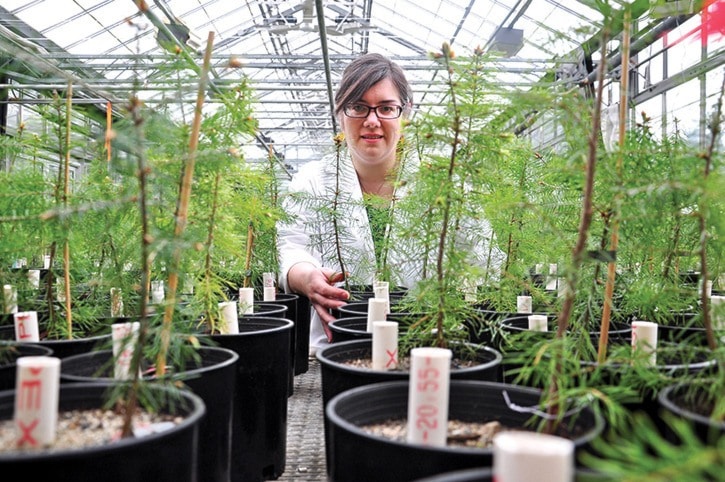It’s hard to tell at a glance, but greenhouses at the Pacific Forestry Centre are home to some stressed out trees.
A veritable forest of 5,000 Interior Douglas fir seedlings, each in its own pot, are waiting for the hammer to drop. Half will be infected with a nasty fungus normally carried by the Douglas fir beetle. The remainder are fated to become blighted with two different kinds of often-fatal root rot disease.
Three thousand other Douglas firs have already been squeezed dry from various levels of an imposed drought. Stressing out trees at the Saanich-based federal forestry lab is an effort to find Douglas firs that will not only survive through hard times, but are genetically hearty enough to thrive.
It’s those rare genetic traits of both tolerance and resistance that research scientist Elisa Becker is hunting for.
Facing a shifting climate over the long term and plenty of diseases and pests, zeroing in on genetic advantages will help promote higher survival rates for tree planting, and ultimately improve timber yield and quality for one of B.C.’s most economically valuable trees.
“(Forestry managers) want trees that grow fast, but you might get less quality and get root diseases faster,” Becker says. “It’s a bit of a trade-off. We realize now (growth) isn’t the only goal. You want fit trees that can withstand stressors and have quality. We want to see if we can get everything without trade-offs.”
For the next few months, the seedling forest at PFC will be watered and grown, before fungus “lollipops” are inserted into PVC tubes that reach the roots in each pot.
After a year, each of those thousands of trees will have employed strategies to combat infection – some might stop growing, while others may develop large lesions within the wood. Some, a small number, might fight off the fungus and keep growing dense timber almost as if nothing were there.
Becker’s team has seen this tolerance and resistance in action in the drought phase of the study last year.
“With drought, some handled being dry and grew, and some shut down,” she says. “Normally we’d look for resistance of what the tree can survive and how it limits damage. But tolerance is important. If there is a lesion or damage and there’s still good quality wood, we want that.”
In terms of root rot, the PCF study plans to infect its Douglas firs with Phellinus, a coastal fungus, and Armillaria, found in the southern B.C. Interior. Root rot does just that – weakens roots in ways that are largely hidden until the tree falls in a windstorm.
“Root disease is not like the pine beetle, which is bright red. Root diseases are underground eating trees,” Becker said. “It doesn’t impact mortality but it impacts volume, height and growth. If we can improve the quality of wood and volume, this (study) will make a difference that way.”
The work builds off similar research on increasing resistance to root-rot led by forestry centre scientist Mike Cruickshank. The study led by Becker is the largest, the first to stress out the same variety of tree in multiple ways.
“Trees react differently to disease, but when tree growth is affected, wood quality will be affected as well,” Cruickshank said in a May 2011 edition of Information Forestry. “This is a major issue upstream on the value chain, where people rely on consistent wood quality.”
Barry Jaquish, a B.C. Ministry of Forests scientist at the Kalamalka Forest Centre in Vernon, provided PFC with the Douglas fir seedlings, and is a partner in the study.
Understanding resistance and tolerance could lead to improved tree breeding for the 15 to 16 million Douglas fir seedings planted each year in the Interior, he said.
“We want to make sure the trees planted have a good chance to survive and grow. It’s not a huge problem, but it’s of economic importance,” Jaquish said. “If there is Armallaria (fungus), we lose a lot of those trees.”
Building pest- and disease-resistant forests, which extends to other species like weevil-resistant spruce trees, is also about being prepared for impacts of climate change within British Columbia and Canada. The expectation is that the overall climate will be drier and more prone to tree diseases.
“It’s a challenge. We think with climate change there will be more of these host-pest problems,” Jacquish said. “We want to be proactive and responsive to these things.”
editor@saanichnews.com
